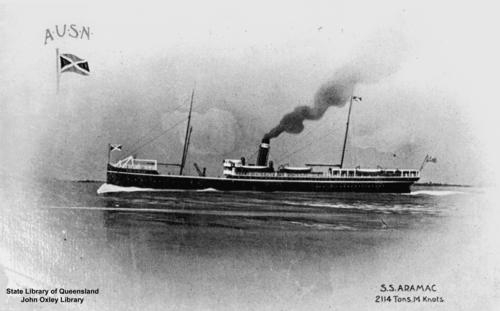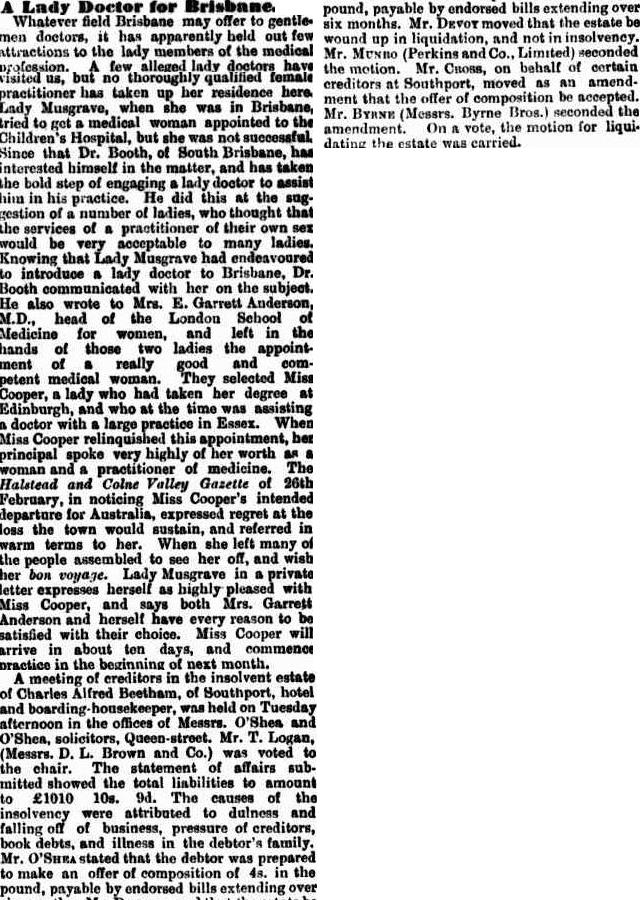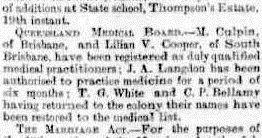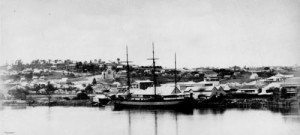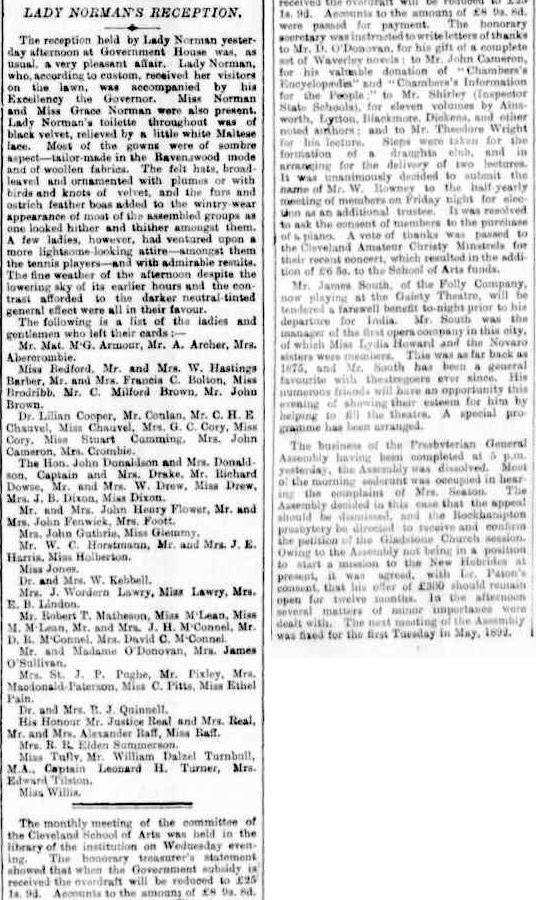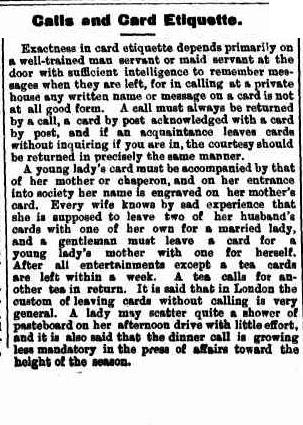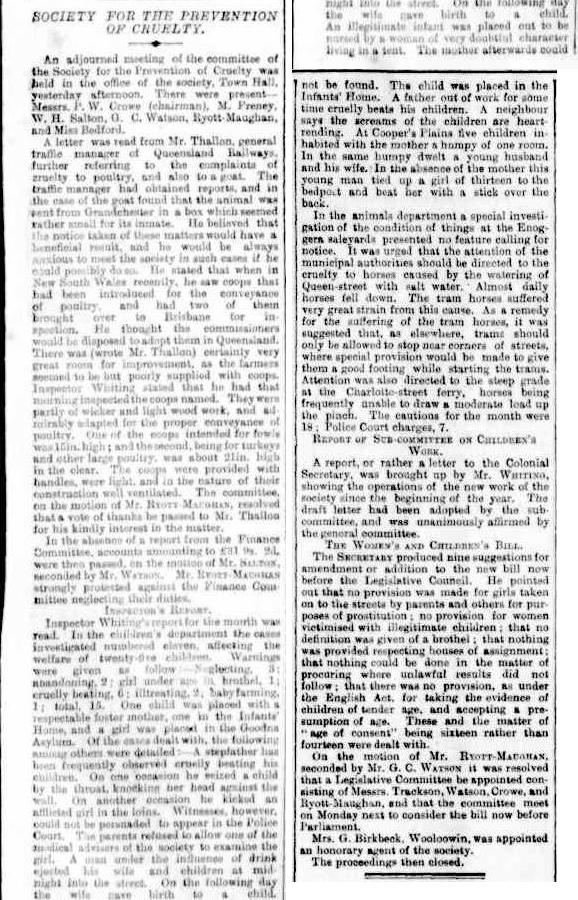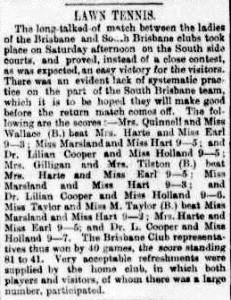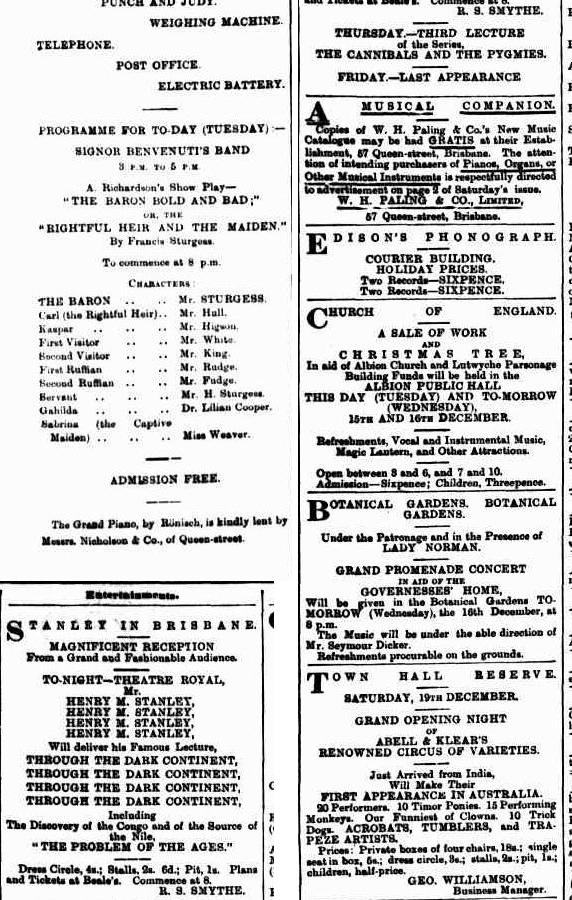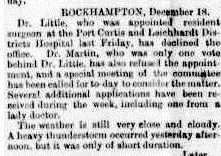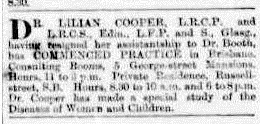1891 - Dr Lilian Cooper's first year in Australia
My partner Aleathea and I are writing a musical about Lilian Cooper and her partner Josephine Bedford. One of my first research tasks was to find out everything I could about Lilian's experiences in that year.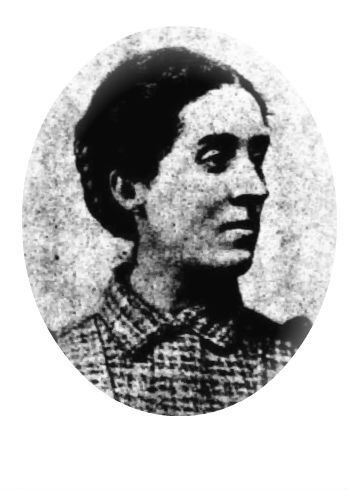
A little back story first:
In 1891, Dr Cooper was living in Essex, England. She was working as an assistant to a doctor. (The history books say she was poorly paid and overworked, but I can't find any primary source material to confirm this.)
Lilian's best friend - and, in my opinion, her life partner - was a woman called Josephine Bedford. They'd been friends since childhood - the story goes that they swore to never be parted (and are indeed buried in the same grave at Toowong Cemetary in Brisbane).
One day, Dr Cooper received word from her old university lecturer that the inhabitants of a little town in Brisbane, Australia wanted a female doctor: would she like the challenge?
Together, Lilian and Josephine set off to Australia.
I can't comprehend the bravery of Lilian and Josephine as they accepted this opportunity. What did they know of Australia? What did they know of Brisbane? How did they find the courage to leave their families and friends, and all that was familiar? Perhaps Lilian might have read the 1883 publication Town Life in Australia to learn what to expect - but this popular little book doesn't even mention the small town of Brisbane (except to say its politicians are particularly rowdy!). In many ways, Lilian was sailing into an absolute unknown.
So what did she encounter when she arrived? How did the people of Brisbane treat her? What did she do, on a day to day basis?
In one of the most interesting research projects I've undertaken, I have hunted for every single reference to Lilian Cooper for the first year of her life in Australia.
The research pieces together Dr Cooper's rich and fascinating life in Brisbane, where she and her parter Josephine Bedford were an integral part of the social, political and community life of Brisbane. It also reveals a Brisbane that is strangely progressive and ridiculously energetic. Dr Cooper, Josephine and their friends were out practically every night, working towards making Brisbane a better place to live. I live in Brisbane, and a lot of what I take for granted is directly due to the efforts of these amazing women and men.
Below is a summary of my research. Enjoy.
May: A lady doctor is coming to town!

This photograph of Brisbane was taken in 1895 but it's very similar to what Lilian and Josephine would have seen on their arrival.
When I found the newspaper article below, it blew me away. Why?
Because it reveals a very different story to the one I'd read in many history books. Up until now, it's been the accepted truth is that Lilian Cooper was invited to Brisbane as a cruel jest by drunken Dr Booth.
This article, however, reveals a different story:
"Dr Booth ... has taken the bold step of engaging a lady doctor to assist him in this practice. He did this at the suggestion of a number of ladies, who thought that the services of a practioner of their own sex would be very acceptable to many ladies."
Here's the article in full.
Notice that Lilian is referred to as "Miss Cooper". The newspapers, in the early days, refer to Lilian Cooper only as "Miss", not "Doctor". It's as if the term "Dr" is too masculine to apply to a woman.
And this isn't surprising. Female doctors were thin on the ground. At the beginning of 1891, there was only one female doctor in Australia: Dr Constance Stone. (Two other Australian women had graduated overseas, but never returned: Dr McCulloch Knight died during her post-grad studies, and Dr Stella Taylor lived in America.)
However, by the end of 1891, three more women graduated as doctors in Australia: Dr Margaret Whyte, Dr Clara Stone and Dr Laura M. Fowler. And one more woman had graduated in England: Dr Dagma Berne.
But at the outset, Dr Lilian Cooper was only the second practising doctor in Australia. And for now, she goes by "Miss". In fact, she referred to herself as "Miss" on her boat trip out to Australia.
But the time would come when everyone, including Lilian, would know without a shadow of a doubt that she was a "Dr".
How have times changed?
What a difference a century makes. The Australian Bureau of Statistics states: "Historically, there have always been many more male than female doctors. In 1986, a quarter (25%) of GPs and less than one in six (16%) specialists were women. While male doctors continue to outnumber their female counterparts, the difference now is far less pronounced. In 2011, 43% of GPs and around one third (34%) of specialists were women."
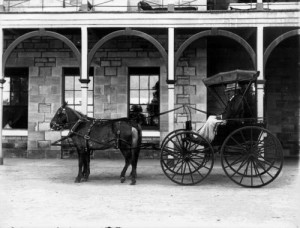
Doctors usually travelled by horse and buggy. This is a doctor outside Brisbane Hospital. Source: QLD State Library.
June: Lilian is registered as a doctor
Just before her 30th birthday, Lilian is registered as a doctor in Brisbane. For the next 6 months she works as Dr Booth's 'assistant' (Lilian refers to herself as an assistant during the 1893 court case of Booth vs Coventry. I've tried to research what this term means, and there were people who called themselves 'doctor's assistants' who had no medical degree. Clearly, this was not the case for Lilian, but it may have been the way that she branded herself in those early days, before she started her own practice.) However, as the article I found below shows, the Queensland Medical Board recognises her as a fully qualified medical practioner. (This is taken from the Brisbane Courier, Tuesday 9 June, 1891, page 6.)
Lilian and Josephine are now living with Dr Booth and his wife Amy, at a house called "Niniu" in Cordelia Street, South Brisbane. South Brisbane is now the cultural hub of Brisbane full of apartments, restaurants, theatres and cinemas, but as you can see in the picture to the right, it was almost rural in the 1890! However, the population was growing fast (it trebled in the 1880s) and South Brisbane was proclaimed its own borough in 1888. I wonder if Lilian and Josephine didn't like living so far out of the hustle and bustle of the city? Only a short while later, they moved right in the city centre, so perhaps this is the case.
It is interesting to note that South Brisbane had (and has) a large Aboriginal population. There is to this day a very obvious signpost of our racist past in South Brisbane: one of the main streets is called 'Boundary St'. This street was so named as it was the boundary of where Aboriginal people were 'allowed' to go after curfew. (Political activists recently defaced the street sign so it reads 'Boundless St' and there's been a push to get the racist street name changed permanently.) I found evidence that Dr Booth and his wife was interested in Aboriginal affairs, and hosted discussions about the subject at their house in Cordelia Street. Reports of these meetings reveal in confronting detail just how violent Australia's past is, and how whities, while attempting to "do good", are severely limited by ingrained racism and paternalistic attitudes. As far as I can tell, Lilian and Josephine were not at those meetings. I can't find any evidence of their involvement in Aboriginal issues.
July: Society welcomes Lilian Cooper and Josephine Bedford
The creme de la creme of Brisbane City are welcomed pretty much every week to Lady Norman's receptions at Government House. Here we see the first of many appearances by Lilian and Jo at these elegant soirees. (You'll notice in the list of guests below, all the 'Mr and Mrs' couples are listed together, but Lilian and Jo's names are separated. This changed over time: as time went by, Lilian and Jo's names were always grouped together, just like any other couple's! This warms my heart.)
In the article above, you'll see the phrase "The following is a list of the ladies and gentlemen who left their cards". Growing up on BBC dramas, I somehow mistook this phrase to mean that you left a card if the host was not at home. However, I think this is wrong. I believe that Lilian and Josephine left their cards and were immediately invited in. You'll see in the article below, the author writes "It is said that in London the custom of leaving cards without calling is very general." So it seems that the custom in Australia was to leave a card AND pay a call in the same visit.
So a few months after their arrival in Brisbane, Lilian is working as a doctor, and both Lilian and Jo are included in the social life of Brisbane.
Let's turn our attention to Josephine for a moment. In the month of July, we discover that Dr Booth, who was a member of the Society for the Prevention of Cruelty, has invited Josephine Bedford along to a meeting. Although Dr Booth would later resign due to some conflict in group dynamics, this would be the beginning of Josephine's lifelong association with the Society.You'll see that, at this stage, the group is called "The Society for the Prevention of Cruelty to Children and Animals." Josephine successfully argued that these are two very different issues. She was eventually instrumental in advising the group to split its focus into two.
Again, I find it interesting that the history books give Dr Booth such a bad rap. Josephine was happy to hang out with him! It's beyond the scope of this updated, condensed version of my research to show every single meeting that they attended together, but there were heaps.
August: Lilian begins working at the beautiful "Mansions"
This is interesting - Lilian Cooper starts working out of "The Mansions": a beautiful new building in the centre of town which would later become her residential address. If I'm reading this ad correctly, however, it looks like she's still living with Dr Booth at Niniu.
These are "The Mansions" which happily survived the 1980's slash and burn of many of Brisbane's beautiful old buildings. I love walking past these buildings and thinking about how Lilian and Josephine lived here for many years.
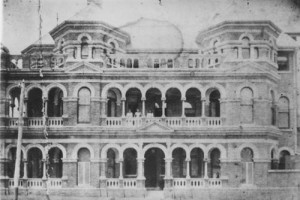
This is what "The Mansions" looked like then... (this photo was taken in 1892, the year Lilian and Jo moved in as residents - I wonder if that's some friends up on the veranda?)
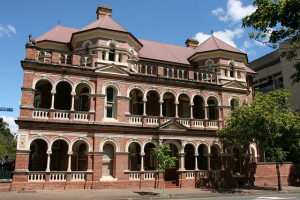
This is "The Mansions" today. Photo: Philip Bouchard
Up until the end of 2017, if you wanted to get inside, you could eat the restaurant there called Augustine's. However, in 2018, the restaurant was closed down as the Queensland Government begins building the new Queen's Wharf.
September: Game on
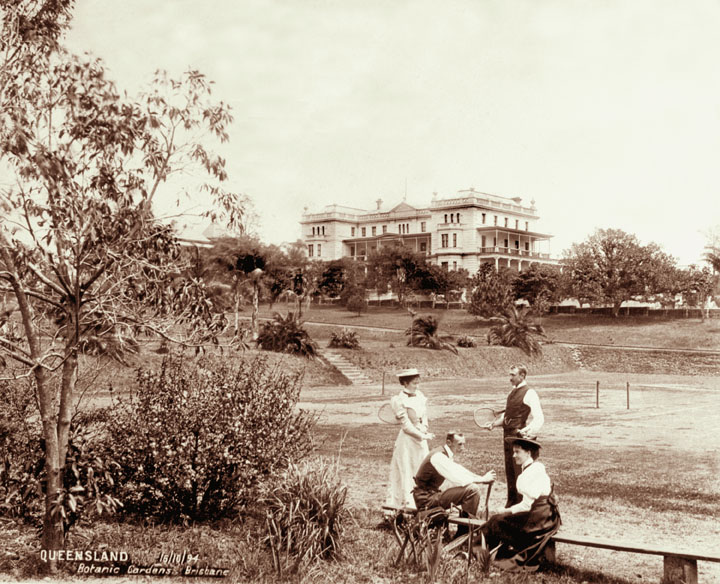
This isn't Lilian! However, I've included this photo (taken near the Botanical Gardens in Brisbane in 1895) to show what sort of clothes the women played in. Lilian Cooper would later campaign for more suitable clothes for Brisbane women. [QLD state archives ID 2566.]
What's this? Lilian Cooper plays lawn tennis? This doesn't fit with the accepted view of Lilian Cooper as a cold, unsocial woman! It gets even better in October... 🙂
October: Curtains up! Lilian treads the boards
What the hell? Dr Lilian Cooper goes on stage in an amateur theatrical! I almost fell off my chair. This is just the best thing ever. I love, love, love the idea of Lilian on stage. Sadly Lilian's life as a thespian was short-lived - she performs again in December, but that's the last we see of her on the stage. 🙁
I was lucky enough to stumble on the complete text of the play under a different title ("The Spirit of 77"). Strangely enough, the play deals with the very issue that Lilian herself is experiencing: that of being a woman in a man's profession. The play is about what would happen if women were given jobs as - gasp - judges, tax agents and other manly occupations. The writer has, of course, made fun of women in these positions. Lilian's own character of the Judge is the object of riducle because she changes her mind during court cases (remember that old belief that women never make up their minds?). But annoying as it is, there's enough in the play to make it gently subversive, so perhaps that's why Lilian agreed to do it. Or maybe she liked the idea of playing a female judge, and didn't realise that she'd be the object of ridicule until too late.
I also found references to how the performers "acquitted themselves creditably" and that there was a repeat performance. There's even a wonderful review that says the performance was attended by a "large and fashionable assemblage" and that Dr Lilian Cooper "was a grave and dignified judicial authority".
December: Entrances....and exits
A busy month for Lilian. She takes part in another show, and sets up her own practice as a doctor.
Below is the second and final reference to Lilian Cooper as a thespian - but please let me know if you find any other evidence! This play is called "The Baron, Bold and Bad" which sound terrible. I can't find any evidence of it anywhere. I researched the author, and I theeenk he was the Language Master at Ipswich Grammar School, so it may well have been a local play that only ever had this one performance. Oh, for a time machine so I could see Lilian play the evocatively named "Gahilda"!
Hmmm, something interesting has come to light. I found this article referring to a "lady doctor" seeking an appointment in Rockhampton. With so few lady doctors running about Australia, I am forced to wonder whether it's Lilian...? And given that she later says (in the 1893 court case of Booth Vs Coventry) that she severed tied with Dr Booth by December 1891, it may well be that she was seeking employment elsewhere.
And now at last, here's the end of the Cooper and Booth partnership. Lilian and Josephine leave Dr Booth's house and set up their own home and practice on Russell St.
But again, I have to question whether there was a bad falling out, as most history books claim. Lilian and Josephine's house was right up the road from Dr Booth's. So surely they'd still be hanging out together...?
View Larger Map
And so ends Lilian's first year in Brisbane! By the time of her death, fifty-odd years later, she and Josephine had changed Brisbane forever. They had established the first kindergartens, were instrumental in creating the RACQ, campaigned for greenspaces all over the city, educated women on how to care for their own bodies, and much, much more. Here's to you, Lilian and Jo.


